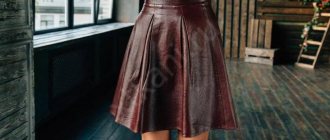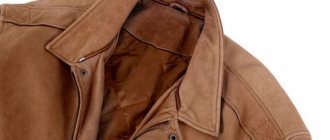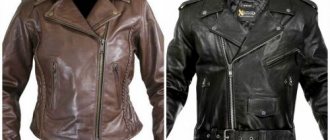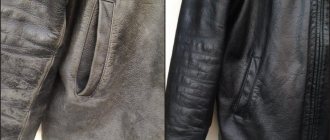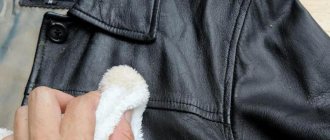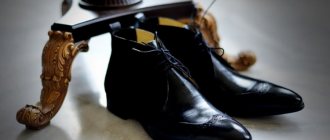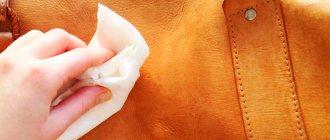Leather is one of the most stylish and versatile fabrics on the planet.
Due to the fact that it is made from animal skin rather than a synthetic/artificial material, it has certain qualities that no other fabric has.
For example, the skin is elastic, smooth and protects against the cold. But some types of products made from this material often become rigid. This doesn't happen overnight. Rigidity occurs with prolonged wear and lack of care for a leather jacket.
Faced with such a problem, owners begin to look for an answer to the question of how to soften a leather jacket so that it can last for more than one season.
Reasons for rigidity
Before moving on to softening methods, it is necessary to understand why this happens with such material.
There are several possible reasons:
- The very first thing is the quality of the leather jacket. Always check with the seller what the leather is made of, what animal skin was used, whether it is really natural or not.
- The jacket becomes stiff if the item is not stored correctly. Most people put their outerwear in a common closet without considering the conditions in it. Leather should not be stored in a very damp place. Just like you shouldn’t place a jacket in a closet with low air humidity. Dry air literally sucks moisture out of your skin, making it hard. Optimal humidity is 40–50%.
Therefore, it is so important to adhere to the rules for storing and drying leather products after washing.
Why leather products become rough
Because of their positive quality characteristics, frequently used leather items are outerwear and shoes - those items that are most exposed to sunlight, rain and low temperatures. If leather items are stored incorrectly after getting wet or being in the sun for a long time, they become rough. Products acquire rigidity and hardness. Such jackets, gloves and shoes are uncomfortable to wear. Of course, products can be returned to their previous appearance by having them repaired or dry cleaned, but they can also be restored yourself.
Currently, there are many different leather care products available on the market. All that remains is to allocate a little time and be patient so that your efforts are rewarded with a positive result.
Cleaning
Before using softening agents, it is necessary to clean the jacket from dirt.
The skin does not like excess moisture, so machine washing is not recommended. All procedures are performed manually using home or professional cleaning products.
If there are no stains, still go over the jacket with a damp cloth soaked in a soapy solution. Small particles of dust can scratch the product when you begin to rub in emollients.
Fat is removed using cornstarch or talc.
Remove lipstick stains with warm water and a sponge.
Under no circumstances should you use chemical solvents such as acetone, sulfuric acid, etc. Such products will not only harm the skin, but eventually you will have to throw away the jacket.
Application of air conditioner
In addition to storing leather products in a climate-controlled environment with a relative humidity of 40-50%, it also requires regular care and proper cleaning.
Use conditioner. This product will soften the material, giving it the necessary moisture.
Leather conditioners are designed to help protect the fabric from drying out. Simply apply the product to the surface of the product, rubbing gently. The conditioner seeps into the pores of the skin, moisturizes and softens it from the inside.
Pre-cleaning
Any thing, even new, needs to be pre-cleaned from external contaminants. To do this, the leather jacket should not be put into the washing machine. It is enough to do the following:
- Before cleaning, prepare a special solution - 1 liter of water plus one tablespoon of liquid soap, preferably baby soap;
- Using a piece of cotton cloth, apply soapy water to the surface in a circular motion;
- Rinse off the soap base with a damp terry towel;
- wipe the item with dry, clean gauze or cotton cloth.
Olive oil
If you don't have access to leather conditioner, use olive oil as an alternative.
Simply pick up a bottle of the product from the grocery store, apply a small amount to a cotton pad, and rub into the surface of the item.
As necessary, wet the fabric and rub again, and so on until the jacket stops absorbing oil.
It is recommended to use coconut oil instead of olive oil. This is an effective and safe solution that will make your skin softer.
How to avoid damaging a leather jacket when processing it for softness?
Now we know how to treat a leather jacket for softness, but it is equally important to choose the right product for each specific case:
- We remind you that castor oil can only be used for dark-colored items; light-colored items may stain.
- If the jacket contains rhinestones, spikes and other accessories, do not use mechanical processing, as you may injure yourself and scratch your expensive item.
- Do not treat the jacket with products containing petroleum and mineral oils. They will ruin the product.
- If possible, it is better to purchase special leather softening products in a store or online; this is the easiest and safest way to soften a leather jacket.
Vaseline and alcohol
Manufacturers allow any alcoholic drinks that contain alcohol to be used for softening.
How to soften leather jackets at home:
- Soak a cotton cloth in a solution made from 1 part vodka and the same amount of water.
- After treatment, the skin will immediately become soft. You just need to repeat the procedure again.
- Then use Vaseline. Apply it on your jacket with your fingers, be careful if your nails are long. In this case, put on gloves and thoroughly rub Vaseline into the skin.
This method is considered one of the best. This option to make the skin softer is welcomed by manufacturers, dry cleaners and studio workers.
Adviсe
Proper storage and care of the jacket will never lead to stiffness of the material. But not everyone knows what can and cannot be done.
After purchasing a new product, immediately read the care information, write it down on a piece of paper or take a photo on your phone.
Recommendations:
- Don't settle for low-quality leather clothing. The jacket may be a little expensive, but you won't have any problems with stiffness later.
- Do not leave your skin in the sun for long periods of time. Prolonged exposure to UV rays can cause fading, drying out and even cracking.
- Never put clothes in the dryer.
- Treat with conditioner every couple of months or so to maintain adequate moisture levels while protecting against harshness.
- Choose products made from full-grain leather.
Be sure to read the label before washing. It indicates how to properly care for the product so as not to end up with a hard jacket.
They can also make the skin softer in a studio if you are afraid to use any products yourself.
Don't let your skin get to this point. From time to time, soak it with special conditioners and impregnations that help retain moisture.
To remove scratches and restore a leather jacket, you need to use a product called “liquid leather.” It is with the help of this tool that you can restore the appearance of the product and continue to use it.
So, we need the following:
- "Liquid leather" the same color as the jacket
- A homemade spatula made from a regular sponge or a piece of sponge
- Hairdryer
- Polyethylene gloves
- Fine sandpaper
- Piece of paper
Restore a jacket
When all the necessary things are already at hand, you can begin the procedure for restoring the item.
- Be sure to wear gloves before starting work. The gloves should be made of polyethylene, since any other material will stick to the product, and we will need to press the problem areas with our hands.
- We take a little product and apply it to paper, it will be much easier for us to draw it from here than from a tube.
- We wet the sponge a little with the product and apply it evenly to the scratch, as if putting putty on it.
- After applying the “liquid skin” to the problem area, press it firmly with your hand. You need to press as hard as possible.
- Next, dry the product with a hairdryer literally for a couple of seconds and press again with your hands.
- We carry out the procedure as many times as necessary so that the scratches themselves cease to be noticeable. As you do this, you will begin to notice uneven surfaces forming. Don't worry, they are all easy to clean.
- We take the finest sandpaper and carefully use it to begin removing all the bumps and protrusions. You need to work with this paper only on problem areas; under no circumstances touch the “healthy” product, as you will ruin the texture of the skin.
- We sand until all irregularities are eliminated.
- After this, we treat the area with the product again. Apply the “liquid skin” in a thin layer to prevent drips from forming, dry it with a hairdryer and press with your fingers.
Carrying out such a procedure is quite simple. The most important thing in this matter is to find “liquid leather” that will perfectly match the color of the product. If you're not sure the color is right, try it on an inconspicuous area of the jacket. If you see even the slightest difference in shade, do not carry out restoration, because the difference in color will be very noticeable on the product.
Glycerol
Glycerin alone cannot be used as a separate emollient.
It is used in combination with beams, a slice of lemon and warm water.
How to soften the skin - algorithm of actions:
- First add the whipped whites. Leave for 4 hours. After the allotted time for the procedure has expired, remove with a damp cloth.
- The second step is to treat the surface with a slice of lemon. Can only be used on light-colored jackets, because the acid contained in this citrus has a bleaching effect. After two hours, the product is wiped again with a damp cloth, then dry.
- And the last - third step - applying glycerin. Soak a cotton pad or soft cloth in the oily liquid and wipe the skin. After 8 hours, the glycerin is also removed and conditioner is applied.
After such manipulation, the skin becomes softer and more elastic. The jacket is more pleasant to wear and does not cause discomfort.
Wax
Leather outerwear will become softer with wax. This product can be purchased at a beekeeping store.
For better results, use wax with Vaseline. Prepare a nutritious paste. Mix both ingredients in equal parts and mix well with a wooden spatula.
Apply the mixture to the surface of the clothing and wait 8 hours. If the composition is absorbed well, repeat the procedure and so on until the skin is saturated.
Remove any remaining product with a soap solution, because Vaseline is difficult to remove with just a cloth.
What explains the increased hardness of the skin?
The leather of various animals is used for tanning: pigs, bulls, cows, calves, crocodiles, snakes and other representatives of fauna. Each animal has its own characteristics of the skin, including hardness. For example, bovine leather is thicker than cow leather, so jackets made from it are much denser and harder. Clothes made from calfskin are quite delicate, but become tougher as the animal ages.
In addition, hardness depends on the processing method. At the tanning stage, the raw material loses its moisture capacity, which makes it impossible to swell upon contact with water, and the mobility of collagen macromolecules is also limited - due to this, strength and wear resistance increase.
The leather is treated with various substances, which allows it to be given the necessary characteristics. For example, chrome tanning makes it elastic and soft, while vegetable tanning increases its hardness. This leather was used to make armor and book bindings.
Lard or fat
If you have one of these remedies in the house, and you don’t want to run to the pharmacy, but you need to save your jacket, feel free to use them.
Melt the fat in a water bath and leave to cool slightly. Do not use liquid that is too hot; the skin may shrink.
Rub the product into the product with a napkin and leave it alone until it dries completely. At the end, you can additionally lubricate the jacket with baby cream or castor oil.
